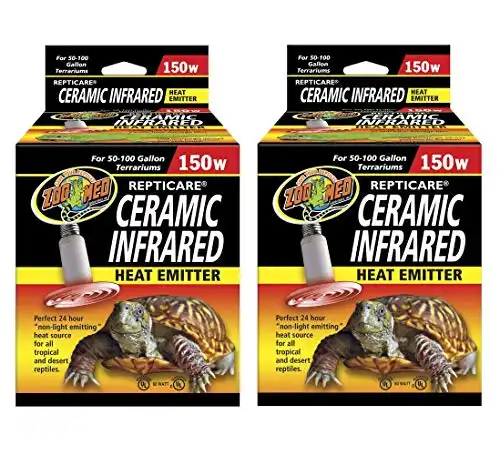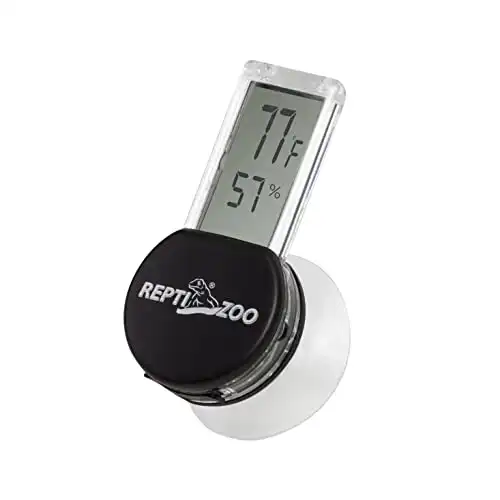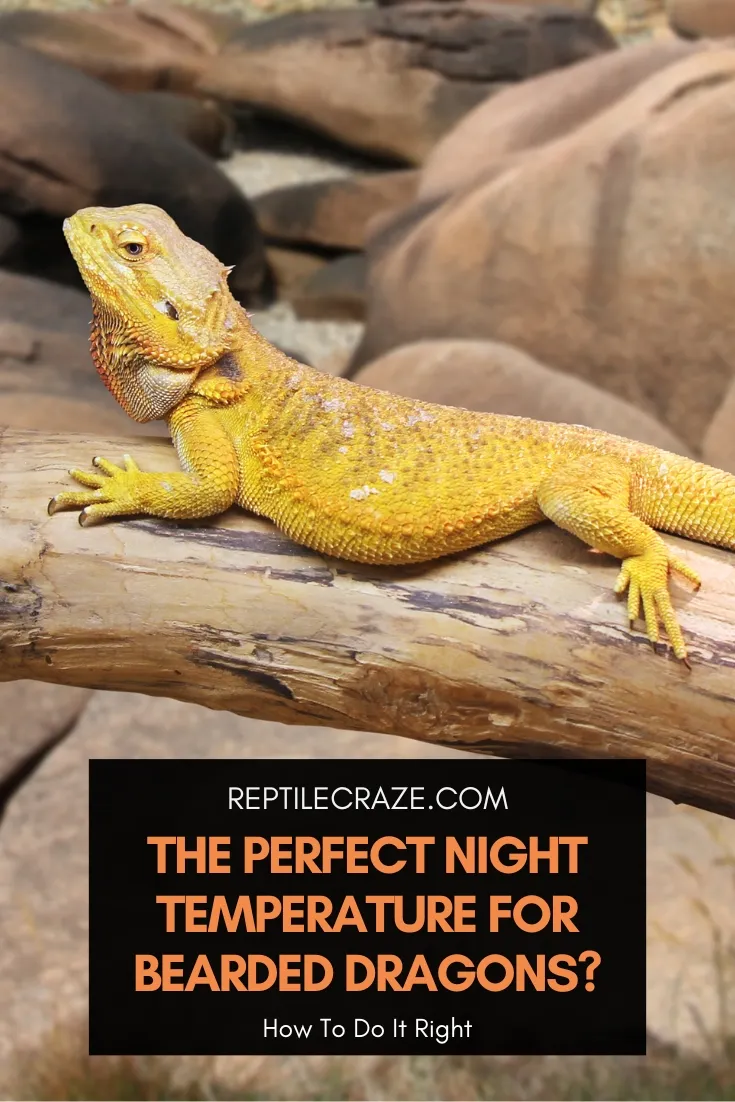
Temperature can be a highly debatable issue in bearded dragon husbandry. You will find many articles giving conflicting answers on what the perfect nighttime temperature range for bearded dragons is.
The perfect nighttime temperature range for an adult bearded dragon is 65°F–75°F (18°C–23°C). However, wild bearded dragons have been known to tolerate nighttime drops as low as 50°F (10°C) without harm.
Although studies have observed wild bearded dragons unaffected by extreme nighttime temperatures, we recommend not going below 65°F as echoed in our article, “Do Bearded Dragons Need Heat At Night?” Read on to learn why we need to maintain an optimal nighttime temperature range for them.
How Cold Can A Bearded Dragon’s Natural Habitat Get?
Bearded dragons may tolerate temperatures as low as 50°F (10°C) without developing illness or going into brumation. For many dragon keepers, that’s a surprise.
But let’s examine the climate of its natural habitat and see why this little lizard can tough it out in temperatures many of us don’t dare tread with our own pets and enclosures.
A wild bearded dragon’s habitat typically lies in warm and arid deserts, subtropical woodlands, savannas, and scrublands in Australia. These vast areas are generally prone to seasons of hot days and freezing nights.
Nights can get freezing over in Australia’s southern and central portions, where bearded dragon populations thrive. Here’s an overview of the average daily lows per season:
| Season | Ave. Low °F | Ave. Low °C |
| Spring | 42.8 | 6 |
| Summer | 53.6 | 12 |
| Fall | 42.8 | 6 |
| Winter | 37.4 | 3 |
The Facebook post by New To Beardies states that there are potentially frosty evenings more than 40 times a year In some southern regions where Central beardies live.
These nights usually take place from June through August and are between 32°F (0°C) and 35°F (1.67°C).
Fun fact: The Australian Museum recounts observing a wild female bearded dragon basking one August winter in an ambient temperature of 59 °F (15 °C)!
The Perfect Night Temperature For Bearded Dragons
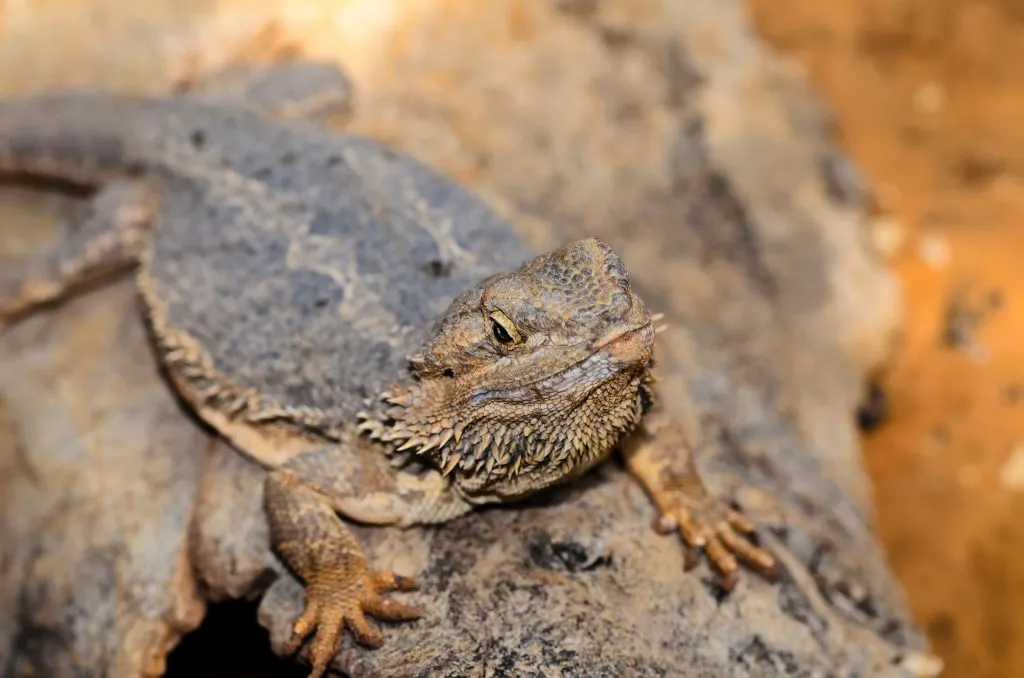
In light of this data, some bearded dragon keepers argue that they can safely maintain a nighttime temperature range between 59°F and 68°F (15°C and 68°C).
Others say a wider temperature range between 55°F and 75°F (13°C and 24°C) won’t harm your dragon.
A lower minimum (even as low as 50°F or 15°C) is acceptable as long as they wake up to an adequate daytime temperature range.
These low nighttime temperatures are thought to trigger basking and warming up in the morning, making for more active beardies like they are in the wild.
In this case, it is essential to maintain the correct basking and warm area temperatures to help warm up cold dragons sufficiently when they wake up.
If daytime temperatures aren’t optimal, you run the risk of cold nighttime temperatures causing illness or triggering unwanted brumation.
Wanna know how long your bearded dragon can go without heat? Read our article on that here!
Listen to this bearded dragon keeper who finds that his pets seem healthier without heat at night. He says his pets still thrive while sleeping in temperatures as low as 40 °F (4.4 °C)!
On the other end of the argument, you will find articles advocating for nighttime temperatures within the range of 70°F–75°F (21°C–24°C).
Drawing from our years of experience, we promote maintaining a safe nighttime temperature range for adult bearded dragons at 65°F–75°F (18°C–23°C).
Treat the other possible temperature ranges as “good-to-know” information. This knowledge can help you avoid unnecessary worry if the enclosure’s temperature drops at night below our “safe” threshold for a few hours.
What If Temperatures Aren’t Right For The Night?
Because there is a wide range of possible acceptable nighttime temperatures, there is a considerable margin for error.
Bearded dragons seem to be able to handle the cold at night better than we humans can.
What great news!
Suppose the power or a heating bulb goes out at night for whatever reason. You don’t need to panic if you can’t get it back up. Your pet could be fine sleeping in colder ambient temperatures.
Just decide what your minimum safe threshold is.
Although many of us think 65°F–75°F is an acceptable range, at least you know that some successful keepers have discovered that a low threshold temperature is possible at 40°F (4.4°C).
Tip: It’s more important to ensure optimal daytime temperatures than to worry about nighttime temperatures.
Remember to have the correct basking and warm area temperatures when they wake so they can sufficiently warm up.
Bearded dragons could become lethargic, lose their appetite, and develop digestive issues if daytime temperatures are not warm enough. They may even go into brumation.
Here is a chart of ideal temperatures based on a study on central bearded dragons posted by BeardieVet on their Facebook page.
| Areas | Temp. Range °F | Temp. Range °C |
| Surface temp. of basking spot (hottest) | 108 -113 | 42 – 45 |
| Surface temp. of warm area | 90 – 100 | 32 – 38 |
| Surface temp. on coolest area | 75- 85 | 24 – 29 |
| Air temp. range | 72 – 99 | 22 – 37 |
How To Maintain Optimal Nighttime Temperatures
You may not need any special heating equipment or light if the ambient temperature of your bearded dragon’s enclosure sits within the correct range for the night.
But if it drops below the minimum you set, your bearded dragons may need extra heat at night.
What Products Are Recommended?
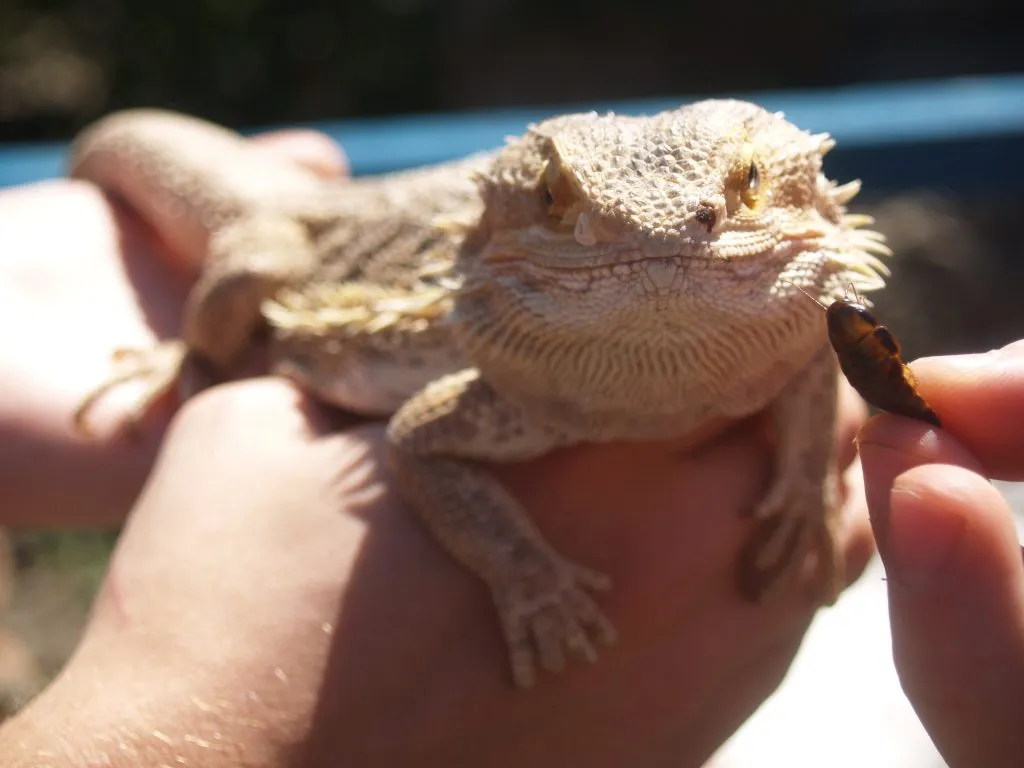
Ceramic Heat Emitter
The best option for providing nighttime heat is a ceramic heat emitter (CHE). These bulbs should also be one of your staples for heating the enclosure during the day.
CHE lamps are excellent for maintaining nighttime temperatures within range. These produce intense heat, but they do not give off light. As such, they do not disrupt the sleep patterns of bearded dragons, which need a stable night-and-day cycle to stay healthy.
CHE lamps produce infrared waves that heat the air surrounding the emitter and, eventually, the air in the enclosure.
The bulbs screw into standard light bulb fixtures and should go in a ceramic deep dome fixture like the basking bulb. You can also get them in different wattages.
Be aware that although CHE lamps produce heat, you should still use a dedicated basking lamp during daytime.
Bearded dragons depend on the UVB light from this source and typically equate light with heat.
A ceramic heat emitter can run 24/7 and raise ambient temperatures quickly.
It is relatively inexpensive as its lifespan is significantly longer than that of incandescent bulbs.
Heat Mats
Heat mats may be another go-to option. As supplementary heaters, these don’t heat as efficiently as CHE lamps. But if the enclosure does not need much heat at night, these may serve as the only heating element.
The safest place to place the heat mat for a bearded dragon is on a wall outside the
This photo shows the heat mat placed underneath the

Digital Thermometers
Thermometers are necessities a reptile keeper cannot do without.
A digital thermometer is the most accurate for reading ambient temperatures. A probe measures the air temperature. This device is powered by a small battery and attached to the wall of the enclosure. The screen shows readings in both Celsius and Fahrenheit.
Sometimes, the thermometer also includes a hygrometer to display humidity levels.
Tip for newbies: An infrared thermometer gun does not measure the air temperature of an enclosure.This type of thermometer is only excellent at measuring surface temperature, such as that of a basking stone.
What Products Are Not Recommended?
There are many things in the pet trade that reptiles don’t need, aren’t helpful, or can even hurt them in the long run.
Let’s look at some products we don’t recommend to help your bearded dragon sleep soundly at the right temperature at night.
Colored Night Lights or Moonlights
If a pet store tries to sell you colored heat bulbs, do not buy them!
These are incandescent bulbs that are colored red, black, or blue.
Bearded dragons do not need light at night. Any light can disrupt their circadian rhythm and eventually threaten their health.
Although marketed for low lighting, colored bulbs still emit light.
Contrary to popular belief, bearded dragons can see red light. Red lights have been demonstrated to irritate the eyes of lizards.
Colored bulbs also do not provide sufficient heating as CHE lamps. These make them unnecessary and potentially harmful fixtures for a bearded dragon’s habitat.
Deep Heat Projectors
Deep heat projectors (DHP) work better for heating than ceramic heat emitters.
Although they make excellent daytime heaters, DHP lamps shouldn’t be used at night.
Unfortunately, DHP lamps emit some light, which may disrupt the sleeping pattern of a bearded dragon.
You may want to follow the discussion on the pros and cons of CHE and DHP lamps in this video.
Heat Rocks and Heat Caves
In reptile terrariums, never use heat rocks or caves.
No thermostats control the heating elements inside these types of accessories.
They can get very hot and cause burns on the bearded dragon’s belly and back legs. Some of these burns have proven fatal.
In Conclusion
People have different ideas about the best temperature range for bearded dragons at night.
Bearded dragons in the wild can live in temperatures as low as 50°F (10°C). Still, it is safer to keep a minimum temperature of 65°F (18°C) for dragons kept as pets.
Bearded dragons do best at night when the temperature is between 65°F and 75°F (18°C and 23°C).
It is essential to know that if the temperature at night drops below the minimum safe level for a few hours, it might not hurt bearded dragons. But maintaining optimal daytime temperatures is vital to keeping them healthy.
Consider getting ceramic heat emitters, heat mats, and a high-quality digital thermometer to ensure you achieve and maintain comfortable nighttime temperatures for your pet.
Avoid colored night lights or moonlights. They can irritate a bearded dragon and throw it off its sleep cycle.
It would also be best to avoid heat rocks and caves because they can cause severe burns.
Bearded dragon owners can make sure their pets are comfortable and healthy at night by following these tips.
- Eastern Rat Snake: Nature’s Pest Control and Fascinating Reptile - September 20, 2024
- Eastern Racer: The Fast and Agile Snake - September 19, 2024
- The Eastern Indigo Snake: The Majestic, Non-Venomous Hunter of the Southeast - September 18, 2024

